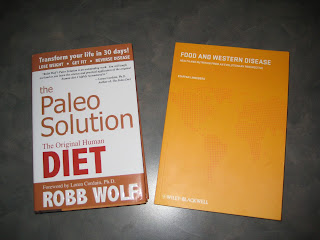Pagans Unite!
I actually couldn't think of a wittier title, but Dec 21st is one of my favorite times of year. The days now start getting longer, and the sun a bit higher. While Jan. 1st is held in regard as the "rebirth" of a new year, I think of Dec 21st as the turning point on my calender. Anyways, onto the goods; first off, a vid from Prof. DeVany:
Art DeVany pimpin' out his new book. I think I know a bookshelf it'll be on.
Effects of olive oil and its fractions on oxidative stress and the liver's fatty acid composition in 2,4-Dichlorophenoxyacetic acid-treated rats
Nutrition & Metabolism 2010, 7:80doi:10.1186/1743-7075-7-80
| Published: | 29 October 2010 |
Abstract
Background
Olive oil's beneficial effects are not only related to its high content of oleic acid, but also to the antioxidant potential of its polyphenols. In this study, we assess the effects of virgin olive oil and its fractions on 2,4-D- induced oxidative damage in the liver of rats.Methods
Male Wistar rats were randomly divided into eight groups of ten each: (C) a control group, (D) group that received 2,4-D (5 mg/kg b.w.), (D/EVOO) group treated with 2,4-D plus extra virgin olive oil, (D/OOHF) group that received 2,4-D plus hydrophilic fraction, (D/OOLF) group treated with 2,4-D plus lipophilic fraction, (EVOO) group that received only extra virgin olive oil, (OOHF) group given hydrophilic fraction and (OOLF) group treated with lipophilic fraction. These components were daily administered by gavage for 4 weeks.Results
A significant liver damage was observed in rats treated with 2,4-D via increased serum levels of transaminases and alkaline phosphatase, hepatic lipid peroxidation and decreased hepatic antioxidant enzyme activities, namely, superoxide dismutase, catalase, glutathione peroxidase, and glutathione reductase. The liver's fatty acid composition was also significantly modified with 2,4-D exposure. However, extra virgin olive oil and hydrophilic fraction intake during 2,4-D treatment induced a significant increase in the antioxidant enzyme activities and a decrease in the conjugated dienes (CD) and thiobarbituric acid-reactive substances (TBARs) levels in the liver. The lipophilic fraction supplemented to 2,4-D- treated rats did not show any improvement in the liver oxidative status while a marked improvement was detected in the hepatic fatty acid composition of rats supplemented with olive oil and the two fractions.Conclusion
We concluded that the protective effect of olive oil against oxidative damage induced by 2,4-D is mainly related to the antioxidant potential of its hydrophilic fraction.My Thoughts: Most people associate extra-virgin olive oil (EVOO) as being beneficial due to it's high content of MUFAs (monounsaturated fatty acid), specifically oleic acid. While this indeed is a benefit, the polyphenol content, aka anti-oxidant content, goes largely unnoticed. As the results of this study show, these polyphenols can actually reverse damage intentionally induced.
While certain groups (Any banana-eatin' carbaholic vegans in the crowd?) rant and rave about oxidized lipids from a high-meat diet, one can clearly extrapolate that a diet high in animal based protein AND rich in nutrient-dense vegetables, fruits and lipids is advantageous on both sides.
Yes, it's as surprising as it is beautiful.
A Reversal On Carbs<---click to read
My Thoughts: No shit, really?
Dr Bill Davis on Fish Oil
Fish oil: What's the difference?
Ultra-purified, pharmaceutical grade, molecularly distilled. Over-the-counter vs. prescription. Gelcap, liquid, emulsion.There's a mind-boggling variety of choices in fish oil today. A visit to any health food store, or any "big box" store for that matter, will yield at least several, if not dozens, of choices, all with varying and often extravagant claims of purity and potency.
So what's the real story?
Given the analyses conducted over the years, along with my experience with dozens of different preparations, I believe that several conclusions can be reached about fish oil:
Fish oil is free of contamination with mercury, dioxin, PCBs, or furans. To my knowledge, only one fish oil preparation has been found to have a slight excess of PCBs. (This is different from cod liver oil that has been found by one source to have a slight excess of PCBs.)
Oxidative breakdown products differ among the various brands. Consumer Lab (http://www.consumerlab.org/), for instance, has found that several widely available brands of fish oil contained excessive oxidative breakdown products (TOTOX). You can perform you own simple test of oxidative breakdown products: Sniff it. Your fish oil should pass the "sniff test." High quality fish oil should smell non-fishy to lightly fishy. Rancid fish oil with excessive quantities of oxidative breakdown products will smell nasty fishy.
FDA approval does not necessarily mean greater potency, purity, or effectiveness. It just means that somebody assembled the hundreds of millions of dollars to obtain FDA approval, followed by lots of marketing savvy to squash the competition.
This means that there are a number of excellent fish oil products available. My favorites are the liquid fish oils from Pharmax, Nordic Naturals, and Barleans. Capsules from Carlson, PharmaNutrients, and Fisol have also performed consistently. The "big box" capsules from Sam's Club and Costco have also performed well and are wonderfully affordable.
My Thoughts: I've been preaching the benefits of value-based fish oil for a long time; smarter guys than me, specifically cardiologist Dr. William Davis, pimp out the run-of-the-mill fish oil over the brutal pharmaceutical "Hey-Lets-Make-More-Fuckin'-Money" grade fish oil also.
Various Training
I didn't honestly know what I'd have to fill this section based on the past 30 days or so; life sometimes has a way of getting IN the way of life, but despite that fact, I have maintained a semblance of a training schedule.
Dec 2nd, CFLA, 2PM
MetCon
150 Double Unders
Rest 2 Min
150 Kettlebell Swings, 1.5pood (53#)
Rest 2 Min
150 Box Jumps (20"). Total time, 19:22.
Dec 5th, CFLA, 3PM
Snatch Session
Burgener x1 w/dowel, added 1/4 OHS, snatch balance, and hang power snatchBurgener x1 w/45#
Hang Power Snatch, 65#x3
Hang Snatch, 65#x3
Full Snatch
95#x1x3, 115#x1x3, 135#x1x3, 145#x1x3, 155x1x3(PR)
Got some knee wraps on advice from Big G; official Rehband knee sleeves. I've been having patellar knee pain, mostly left sided, since the beginning of Oct (my last snatch session). These feel awesome, and I highly recommend them. Since it had been, what, 2 months since the last time I snatched I sure as hell didn't deserve that PR. But I'll gladly take it. Close to my goal of 165# (BW).
Dec 8th, CFLA, 1PM
"Danny"
AMRAP in 20 Minutes30 Box Jumps
20 Push Press (115#)
30 Pullups
3 rounds + 48 reps. Done as a challenge to Crossfit Flathead; and despite really NOT wanting to crush myself into oblivion, I had no choice after coaching 11/12 and watching the crew smash the hell outa this. Push press killed me, but it wasn't as bad as I thought it would go. Gotta bust 4 rounds next time.
Various Dec Dates@ U of L
Indoor Rock Climbing
If it's one thing I've been hitting regularly, it's been the rock gym. The last time I posted I was working on a 5.11a, which I successfully red-pointed, aka climbed without falling. I'm now working on a very tough 5.11b (which, by the way, MD warms up on. Ha!).
There's a lot of parallels between Crossfit and rock climbing---the wall is static, the weights are static, but I'm the dynamic one pushing a pulling against it. Success or failure depends on overcoming my fatigue, both mentally and physically. Better technique = greater efficiency. Goals achieved will vary from person to person, and it's completely individual.
Dec 13th, CFLA, 1PM
Snatch Complex
-Snatch Grip Deadlift
-Power Snatch
-Back Squat
-Overhead Squat
-Bent Over Row
-Hang Squat Snatch
65#, 75#, 85#, 95#, 105#, 115#, 125#x2. Surprised at how tough those last hang squat snatches are at the end of the complex.


























